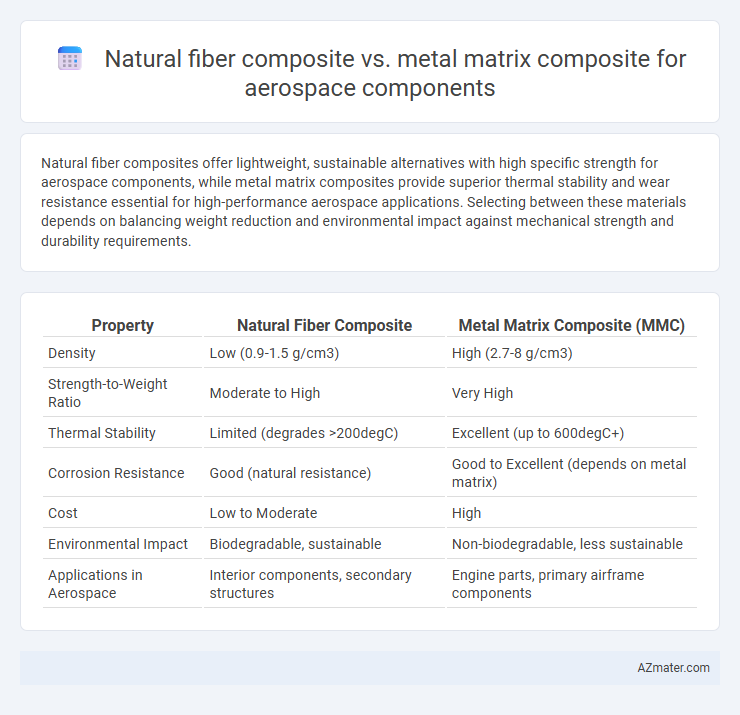Natural fiber composites offer lightweight, sustainable alternatives with high specific strength for aerospace components, while metal matrix composites provide superior thermal stability and wear resistance essential for high-performance aerospace applications. Selecting between these materials depends on balancing weight reduction and environmental impact against mechanical strength and durability requirements.
Table of Comparison
| Property | Natural Fiber Composite | Metal Matrix Composite (MMC) |
|---|---|---|
| Density | Low (0.9-1.5 g/cm3) | High (2.7-8 g/cm3) |
| Strength-to-Weight Ratio | Moderate to High | Very High |
| Thermal Stability | Limited (degrades >200degC) | Excellent (up to 600degC+) |
| Corrosion Resistance | Good (natural resistance) | Good to Excellent (depends on metal matrix) |
| Cost | Low to Moderate | High |
| Environmental Impact | Biodegradable, sustainable | Non-biodegradable, less sustainable |
| Applications in Aerospace | Interior components, secondary structures | Engine parts, primary airframe components |
Introduction to Composite Materials in Aerospace
Composite materials in aerospace combine multiple constituents to achieve enhanced mechanical properties and reduced weight, critical for flight performance and fuel efficiency. Natural fiber composites offer sustainability and lightweight advantages but typically lack the high strength and temperature resistance of metal matrix composites (MMCs), which provide superior thermal stability, stiffness, and corrosion resistance. The choice between natural fiber and metal matrix composites depends on specific aerospace component requirements, balancing environmental impact with performance demands.
Overview of Natural Fiber Composites
Natural fiber composites in aerospace components leverage renewable fibers such as flax, jute, and hemp embedded in polymer matrices, offering advantages in lightweight design, biodegradability, and cost-effectiveness. These composites exhibit high specific strength and stiffness while reducing environmental impact compared to traditional materials. However, challenges include lower thermal stability and moisture sensitivity, necessitating advancements in fiber treatment and matrix compatibility for aerospace applications.
Understanding Metal Matrix Composites
Metal Matrix Composites (MMCs) offer superior mechanical strength, thermal stability, and wear resistance compared to natural fiber composites, making them highly suitable for critical aerospace components subject to extreme stress and temperature variations. Composed primarily of metal matrices such as aluminum, titanium, or magnesium reinforced with ceramic fibers or particles, MMCs provide enhanced stiffness, fatigue resistance, and improved corrosion resistance essential for aerospace applications. Understanding the microstructural behavior and manufacturing techniques like powder metallurgy or casting is crucial for optimizing MMC performance in lightweight, high-strength aerospace parts.
Comparative Mechanical Properties
Natural fiber composites exhibit lower density and enhanced specific strength compared to traditional metal matrix composites, offering improved weight savings critical for aerospace applications. Metal matrix composites provide superior mechanical properties such as higher stiffness, tensile strength, and thermal stability, ensuring better performance under extreme aerospace conditions. The trade-off between lightweight natural fibers and the durability of metal matrices influences component selection based on mission-specific mechanical performance requirements.
Weight and Density Considerations
Natural fiber composites exhibit significantly lower density, typically around 1.2 g/cm3, compared to metal matrix composites which range from 2.5 to 3.5 g/cm3, making natural fibers ideal for weight-sensitive aerospace components. The reduced weight of natural fiber composites contributes to enhanced fuel efficiency and overall aircraft performance by lowering structural mass. Metal matrix composites, while denser, offer superior mechanical strength and thermal resistance but at the expense of increased weight, necessitating careful material selection based on component function and weight constraints.
Thermal and Environmental Performance
Natural fiber composites offer superior thermal insulation and reduced environmental impact due to their biodegradability and low thermal conductivity, making them suitable for non-structural aerospace components exposed to moderate temperatures. Metal matrix composites exhibit high thermal stability, excellent heat dissipation, and resistance to harsh environmental conditions, which is critical for structural aerospace parts operating under extreme temperature fluctuations and mechanical stress. The choice between these materials depends on balancing thermal management needs with environmental sustainability requirements in aerospace applications.
Manufacturing and Processing Techniques
Natural fiber composites for aerospace components utilize techniques like resin transfer molding and compression molding, offering advantages in cost-effective processing and lower energy consumption compared to metal matrix composites. Metal matrix composites require advanced methods such as powder metallurgy, infiltration, and squeeze casting to achieve high-temperature resistance and mechanical strength essential for aerospace applications. The manufacturing of metal matrix composites involves precise control of temperature and pressure, while natural fiber composites emphasize sustainable processing with biodegradable reinforcements, impacting overall production efficiency and material properties.
Cost Analysis and Sustainability
Natural fiber composites offer significant cost advantages over metal matrix composites due to lower raw material expenses and reduced processing energy requirements, making them economically attractive for aerospace components. In terms of sustainability, natural fiber composites provide enhanced biodegradability and reduced carbon footprint, contributing to environmentally friendly aerospace manufacturing. Metal matrix composites, despite higher material and processing costs, deliver superior mechanical performance and thermal stability, which are critical but come at the expense of increased environmental impact and resource intensity.
Typical Applications in Aerospace Components
Natural fiber composites are primarily used in non-structural aerospace components such as interior panels, seat backs, and insulation due to their lightweight and eco-friendly properties. Metal matrix composites find application in high-performance aerospace structures including turbine blades, airframe components, and engine parts because of their superior strength, thermal resistance, and wear properties. The selection depends on the balance between weight reduction and mechanical performance required for specific aerospace functions.
Future Trends and Research Directions
Natural fiber composites offer lightweight, sustainable alternatives with enhanced specific strength, promoting eco-friendly aerospace components, while metal matrix composites deliver superior thermal resistance and mechanical performance critical for high-stress environments. Future research trends emphasize hybrid composites integrating natural fibers with metal matrices to achieve optimal strength-to-weight ratios and improved environmental resilience. Advancements in nanotechnology and bio-based resins aim to boost durability, corrosion resistance, and recyclability, aligning with aerospace industry demands for greener, high-performance materials.

Infographic: Natural fiber composite vs Metal matrix composite for Aerospace component
 azmater.com
azmater.com